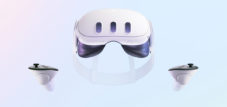Published on: April 5, 2025 / update from: April 5, 2025 - Author: Konrad Wolfenstein

Virtual Reality (VR) and Augmented Reality (AR): A market in the start and competition is raging - Image: Xpert.digital
From toys to key technology: the change from VR and AR
The future of work, learning and interaction in the VR era
The world of Virtual Reality (VR) and Augmented Reality (AR) is in an exciting phase. What was once dismissed as a futuristic gimmick is now a dynamic market that is characterized by rapid growth, technological progress and hard competition. This climb is not only due to improved technology, but also to the growing knowledge that VR and AR offer much more than just entertainment. They revolutionize industries, change the way we learn, work and interact, and pave the way for a future in which the boundaries between the physical and digital world are increasingly blurring.
Suitable for:
- $ 1.7 trillion: the explosive growth of the XR market (Augmented / Extended Reality) and its undiscovered opportunities
Growth driver: more than just games
The driving forces behind this growth are diverse. While gaming continues to play an important role, VR and AR applications are expanding rapidly to other areas. In healthcare, they enable realistic simulations for the training of surgeons, support the therapy of phobias and anxiety and offer innovative solutions for the rehabilitation of patients. In education, pupils and students can explore distant places, experience historical events up close or understand complex scientific concepts in an interactive way.
The manufacturing industry benefits from AR by enabling technicians to carry out complex repairs with real-time instructions that are projected directly on their point of view. Companies use VR for realistic employee training, ranging from the simulation of dangerous situations to improving soft skills. Even retail experiments experiment with AR to enable customers to try virtual rehearsals or to help them visualize furniture in their own four walls before buying.
Technological progress: the hardware catches up
This wider area of application would not be possible without continuous technological advances in the field of hardware. High -resolution displays deliver sharper and more lively images, which increases the immersion and reduces the eye load. Improved lenses, especially the so-called pancake lenses, enable a slimmer design and a better optical performance. More precise tracking systems capture movements with greater accuracy and reaction ability, which makes interaction with virtual environments more natural and more intuitive. Advanced haptic feedback lets us “feel” virtual objects, which further increases the immersion and opens up new opportunities for interactive experiences.
The competition picks up speed
The competition in the VR/AR market is intensive and is powered by several factors. The entry of Apple into the high-end mixed reality segment with the Vision Pro has shaken up the industry and redefined the potential for spatial arithmetic (spatial computing). The rapid reaction of competitors who develop devices that are described as the “clone” of the Apple Vision Pro shows the willingness of the companies to adapt and to fight market shares. At the same time, Meta continues to claim a strong position with new hardware such as META Quest 3 and continuous software and game developments.
Suitable for:
Apple Vision Pro and the “Klone”: a race for innovation and price
Apple's market entry with the Vision Pro has changed the VR/AR landscape. The device positions itself as a high-end-mixed reality headset, which combines advanced technology, elegant design and an intuitive user interface. Apple relies on an ecosystem that is seamlessly integrated with other Apple products, and thus primarily addresses existing Apple users.
Devices that are referred to as “clones” are quickly created in response to the Vision Pro. These devices, such as the Play for Dream MR and the Vivo Vision, try to offer the concept of spatial arithmetic at a lower price. The Play for Dream MR is characterized, for example, by a Snapdragon XR2+ Gen 2 processor, 11 cameras, 7 sensors and 22 LEDs. It projects virtual objects into the real world, uses 4K micro-oled panels and integrates eye tracking. In contrast to the Apple Vision Pro, the Play for Dream MR controller is included, and the operating system is similar. The lower price is a major advantage.
The Vivo Vision is similar to the Apple Vision Pro in the design, including a gray fabric face, a rear strap, an external battery and a corresponding connection. Even the name “Vision” was taken over. The market launch is planned for mid -2025.
These “clone” devices position themselves as cheaper alternatives to the Apple Vision Pro and aim to achieve a wider consumer base with a lower price. Some clones, such as the Play for Dream MR, are aimed at gamers with functions such as controllers and PCVR compatibility. The Vivo Vision seems to imitate the design of the Apple Vision Pro directly and may aim at consumers who like the aesthetics of the Vision Pro, but they are looking for a cheaper option.
The rapid formation of “Apple Vision per cloning” signals a strong market validation for the concept of spatial computing and indicates a race to offer similar experiences at different price points.
Suitable for:
Meta: The established player defends his position
Meta, formerly Facebook, put on VR early and got a strong market position with the Oculus series (now Meta Quest). The company follows a different approach than Apple by relying on more affordable standalone headsets that are aimed at a wider audience. The Meta Quest 3 is an example of this approach. It offers advanced functions at a competitive price and aims to make VR accessible to a broader mass.
Meta also invests heavily in software and content to create an attractive ecosystem for its users. The Horizon platform is intended to create a social VR world in which people interact, play and work together. Due to the continuous development of his hardware and software, Meta tries to defend its management position in the VR market.
Gaming: The Catalyst for Innovation
Gaming remains a crucial factor for VR adoption and innovation. High-quality VR games like Half-Life: Alyx have shown what potential in this technology and set new standards for immersive experiences. The development of VR games also drives technological progress because developers are constantly looking for opportunities to expand the limits of the possible.
The VR gaming market is dynamic and diverse. There is a large selection of games for various tastes, from action -packed shooters to relaxing puzzle games. The continuous publication of new VR games on various platforms, including both standalone titles and VR ports of established franchises, demonstrates the continued vitality and further development of the VR gaming market, which appeals to both committed VR users and potentially new players.
The trend towards compact VR glasses: comfort and portability
Another important trend in the VR market is the growing importance of smaller and more compact VR solutions. The Bigscreen Beyond is a prime example of this development. It is characterized by an ultra -light and compact design and still offers high -quality displays and optics. The BigScreen Beyond illustrates a growing trend in the VR market, which aims at a niche from committed PC-VR enthusiasts, which prioritize first-class visual reproduction, comfort for longer use and a minimal form factor, even if this means the convenience of the standalone operation and a lower price.
The trend towards compact VR glasses deals with frequently expressed criticism of VR technology-its bulkyness and the potential for discomfort. By focusing on improving ergonomics and reducing weight, the manufacturers want to make VR more accessible and pleasant for longer periods of time, which is decisive for both acceptance among consumers and for the use of VR in professional and entrepreneurial environments.
The persistent popularity of Half-Life: Alyx: A milestone in VR history
Half-Life: Alyx, which was published in 2020, is still seen as a masterpiece of the VR games today. It has set standards for the quality of VR games and enjoys high reviews on Steam and Metacritic. The game demonstrates the potential of VR for storytelling and immersive gameplay.
The persistent popularity of Half-Life: Alyx serves as an impressive testimony to the potential of VR, to provide really extraordinary and unforgettable gaming experiences that can last for time. This indicates that high-quality, immersive content is a decisive factor for long-term success and the attractiveness of the VR platform.
Suitable for:
- VR, AR and MR in a global comparison: Regional focuses, technical milestones and current XR market developments
Growth rates and future prospects: A look at the crystal ball
The growth rates for the VR/AR market are assessed differently by various sources, which reflects the dynamics and the continuous development of this sector. However, the forecasts all indicate significant growth in the coming years. A report predicts an average annual growth rate (CAGR) of over 50 % until 2030.
It is expected that the focus of the growth of pure headset sales is relocated to software, content and corporate solutions. The augmented reality (AR) will also play an increasingly important role because it enables greater integration into everyday life.
The perspectives of the VR/AR market: development, acceptance and content
Despite the promising view, the VR/AR market faces some challenges. The costs for high-quality VR/AR systems can still be a hurdle for many consumers. The usability and the comfort of the headsets must be further improved to ensure broader acceptance. The development of convincing content that fully exploits the possibilities of VR and AR is also crucial for long -term success.
Nevertheless, the opportunities predominate. Technological progress will reduce costs and improve performance. The growing acceptance of VR/AR in companies will open up new areas of application. The development of new and innovative content will arouse the interest of consumers.
The competition is driving the innovation ahead
The competition in the VR/AR market is a decisive factor for innovation. Companies such as Meta, Apple and others are fighting for market shares and investing strongly in research and development. This competitive pressure leads to increasingly progressive functions, better user experiences and a wider range of applications.
A look into the future: the fusion of reality and virtuality
The future of the VR/AR market looks rosy. We can expect VR and AR to be increasingly integrated into our everyday life. You will change the way we work, learn, play and interact. The boundaries between the physical and digital world are increasingly blurred, and we will move in a world that seamlessly merge together in reality and virtuality.
A market in the departure
The VR/AR market is located in a dynamic and exciting stage. The technology matures, applications become more diverse and the competition is intensified. While there are still challenges to overcome, the chances of considerable growth and a transformative effect on various industries and our everyday life indicate. The future of virtual and augmented reality is promising and we can be excited to see what the coming years will bring. The companies that drive innovations, develop high -quality content and meet the needs of users will be successful in this rapidly developing market.
Suitable for:
Your global marketing and business development partner
☑️ Our business language is English or German
☑️ NEW: Correspondence in your national language!
I would be happy to serve you and my team as a personal advisor.
You can contact me by filling out the contact form or simply call me on +49 89 89 674 804 (Munich) . My email address is: wolfenstein ∂ xpert.digital
I'm looking forward to our joint project.















